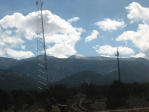It was a beautiful summer’s day as the pilot and his family were flying back in the late afternoon after visiting friends in Sacramento. Over Concord the pilot could see that the marine cloud layer was blanketing the Bay Area with the coastal stratus just touching the tops of the East Bay hills. He thought he could see under the clouds over to the Bay side, but it was really just an illusion of light bouncing off the clouds and maybe some wishful thinking on his part. No matter, he knew the area well and would just stay below the clouds to get home.
 As he approached the hills he had to descend little by little to keep from entering the scud. To stay under the clouds he descended below the ridgelines and was now flying through the passes. A feeling of unease started to creep in. At this low altitude all the familiar landmarks melted into the homogeneous terrain and he wasn’t quite sure of where he was or where he should be going. He turned to avoid entering the clouds blocking his path, but had little room to maneuver. In an instant the windshield turned a solid gray-white causing a complete loss of orientation as to which way to go. Seconds later there was a loud “blaam” followed by eternal silence.
As he approached the hills he had to descend little by little to keep from entering the scud. To stay under the clouds he descended below the ridgelines and was now flying through the passes. A feeling of unease started to creep in. At this low altitude all the familiar landmarks melted into the homogeneous terrain and he wasn’t quite sure of where he was or where he should be going. He turned to avoid entering the clouds blocking his path, but had little room to maneuver. In an instant the windshield turned a solid gray-white causing a complete loss of orientation as to which way to go. Seconds later there was a loud “blaam” followed by eternal silence.
It is a tragic scenario that plays over and over again. This is the most common type of fatal accident that I investigate in the Western States and it occurs all too often in our area where we have an abundance of coastal stratus and hills. It happens to both instrument and non-instrument rated pilots alike. Scud running is one of the most dangerous flying activities you can undertake because, as with the pilot above, it can seem like a fairly benign idea to begin with, but may turn out to be a lethal one-way trap.
 What constitutes scud running? Well, even undefined you pretty much know it when you are doing it (and you usually don’t feel good about it). I tend to think that anytime you have less than a 1000 feet of altitude between the ground and the base of the clouds you are running short of VFR maneuvering room. Even when the terrain is flat, surface elevations and cloud bases will vary over distance and may shrink your safety margins quickly. Other lethal hazards associated with scud running include hitting obstructions such as utility structures or wires. Even without obstructions, spatial disorientation from an inadvertent cloud encounter can cause a non instrument pilot to lose control of the aircraft.
What constitutes scud running? Well, even undefined you pretty much know it when you are doing it (and you usually don’t feel good about it). I tend to think that anytime you have less than a 1000 feet of altitude between the ground and the base of the clouds you are running short of VFR maneuvering room. Even when the terrain is flat, surface elevations and cloud bases will vary over distance and may shrink your safety margins quickly. Other lethal hazards associated with scud running include hitting obstructions such as utility structures or wires. Even without obstructions, spatial disorientation from an inadvertent cloud encounter can cause a non instrument pilot to lose control of the aircraft.
Like walking into quicksand, the danger may not be apparent until it is too late to retreat. The solution is easy: Don’t go there. Don’t even think about it. If low clouds block your path don’t be tempted to sneak under. Light can play funny tricks and tempt you with false illusions of clearing in the distance. See if you can circumnavigate a safe route even if takes a bit longer.
If you are qualified, current, and equipped for instrument flight, make the effort to request an IFR clearance. If not, then land and consider your options to either wait it out, rent a car, or spend the night. Tomorrow is another day and it is better than the alternative.
Editor’s Note: This article was written by Ken Steiner prior to his retirement from the United States Aircraft Insurance Group as a Vice-President and Claims Manager. During his career, Ken investigated thousands of aircraft accidents involving small planes, crop dusters, helicopters, corporate aircraft, and airliners. He has been on-site at over 100 fatal aircraft accident investigations. He is currently an Aviation Investigative Consultant and is also a Pilot and Tactical Flight Officer for the San Mateo County Sheriff’s Air Support Unit. He owns a Cessna 182 based at San Carlos and holds ATP and CFI certificates with over 5000 flying hours.


